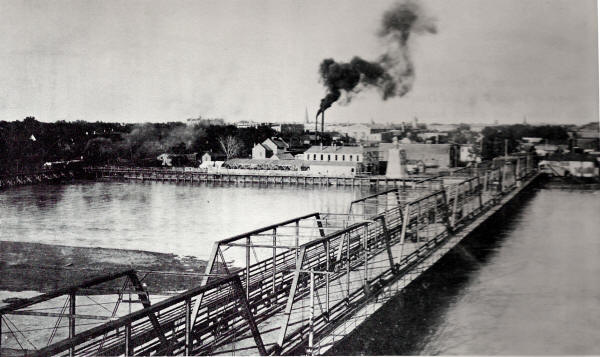|
Then and Now: First Douglas Avenue Bridge
|
|
THEN: The first Wichita structure to span the Arkansas River was an eight-span toll bridge at Douglas Avenue and built in 1872. |
|
|
|
NOW: Reconstructed in 1999, the Douglas Avenue Bridge features pedestrian walkways, seating and 60-foot steel towers. |
A Ferry Preceded a Bridge Crossing the River
Editor’s Note: Information in the following article has come from The Wichita Eagle, The Wichita Beacon and Peerless Princess of the Plains.
Bridge safety is on the minds of many these days, but, in Wichita’s early days, the simple existence of any bridge was cause for celebration.
"Before the Arkansas River was bridged at Douglas Avenue, the community on the west bank felt so isolated from Wichita that it called itself by another name – Elgin at first, and later Delano." (Peerless Princess)
In fact, there wasn’t even a ferry until May 1871. A history piece in the Nov. 17, 1932 Wichita Evening Eagle said, "The river at Wichita was once very wide, carried a lot of water and was measurably free from ‘islands.’
"The eastern end of the ferry was somewhere east of the Broadview hotel of this day. Incidentally the first plat of this addition shows the present corner of Waco and Douglas as nonexistent. It was river bank then. The western end of the ferry was north of the present Midland station. On each bank was a wooden tower, and from tower to tower stretched rope.
"The raft was attached to this trolley rope by two ropes, these ropes equipped with wheels. The raft had no power. It crossed and re-crossed the stream by a manipulation of the current of water. Going from east to west the rope on the west side of the craft was slackened, and going from west to east this rope was tightened and the rope on the east end of the raft slackened. The force of the current did the rest in either trip.
"The fare was 10 cents for foot passengers, 50 cents for one team and an unloaded wagon; one dollar for one team and loaded wagon."
Cattle simply had to be herded across at any low point the drivers could find.
That ferry lasted only one year. In the fall of 1871 a group of entrepreneurs, including William Griffenstein, N.A. English, James R. Mead, Nelson McClees and Charles Gilbert set about to build the first bridge to span the Arkansas.
The 1,000 foot long bridge had stone piers and abutments resting on foundations of tubular iron piling driven deep into the river bed. There were eight spans of 100 feet each, with a 16-foot roadway and a toll house at each end allowing Douglas Avenue to join Wichita and Delano. Peerless Princess says, "After the toll bridge was completed . . . the separate identity of Delano ended."
The structure cost $29,000 and, as continues to be the case with entrepreneurs, the company was short of cash when the bridge was opened for traffic, June 12, 1872.
In that instance, however, the owners traded in some town lots in partial payment, and toll income proved to be great enough to pay off all expenses and make the business men no small amount of money.
By the latter part of 1874 there was a growing sentiment in favor of making the bridge free. An examination in January 1877 showed that, except for six or eight timbers, the bridge was structurally sound. Under each channel pier there were 15 piles, and under the east abutment 28 piles driven as deep as possible, or to about 18 feet below the low water mark.
An election was ordered by the commissioners to be held Feb. 6, 1877, in order to purchase the bridge. This met with popular approval, so city, county and private resources were combined, and the bridge was purchased.
The July 4, 1877 Beacon said, "The Douglas Avenue Bridge is free for all time to come. The County paid $1500 and the city $1000. The balance of the $5,000 was raised by private subscription."
By 1908, the Arkansas River was not as wide as it had been, and, when that first Wichita bridge was replaced in 1908, the new concrete structure had only seven elliptical arches.
Unlike much of our current throw-away culture, however, several, if not all, of the spans of the first bridge were not demolished. They were moved to various locations in the county to span small waterways.
And that brings us to the beginning of HPA. Our organization grew out of the Save the John Mack Bridge Committee, which was formed when city officials decided that depression era structure was too old to be safe and wanted to tear it down.

